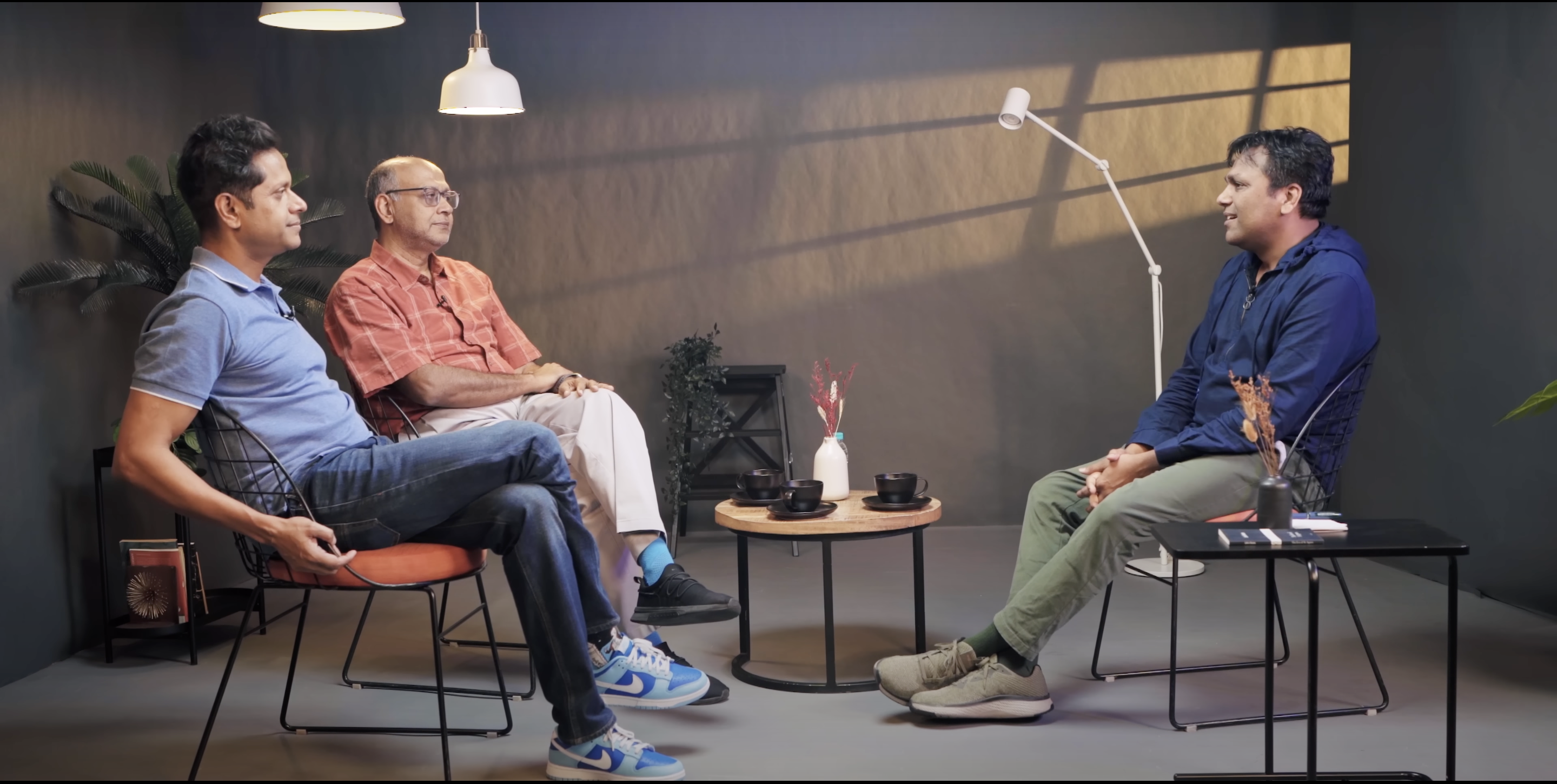
SUMMARY
Serial entrepreneur Mukesh Bansal and Accel’s Subrata Mitra discuss how startup founders can survive, scale and build sustainable businesses
Know when to let people, who are no longer the right fit, go. Keeping them for long can hurt the culture and performance of your startup, advices Bansal
You don’t just scale companies, you also scale your approach and mindset as an entrepreneur, says Mitra
Indian entrepreneurs have inspired and impacted the country’s business outlook for generations. While the likes of N.R Narayana Murthy and Azim Premji heralded the IT revolution, new-age startup founders such as Mukesh Bansal have spearheaded the tech revolution. Bansal has worn many caps as an entrepreneur. He founded Myntra (owned by Flipkart), becoming a pioneer in the fashion ecommerce segment. In 2016, he founded fitness startup Cult.fit, along with Ankit Nagori. Today, Cult.fit enjoys celebrity status in India’s healthtech space.
In this masterclass of Accel Seed To Scale’s #DecodingMarketplaces, journalist Pankaj Mishra spoke to Bansal and Accel’s Subrata Mitra (an investor in both Cult.fit and Myntra) on how it all came about.
Survivability
“If you want to startup, figure out how you are going to survive for five years”
The early days of any startup are all about pivots and figuring out product market fit. Myntra is one of the earliest startups in the ecosystem and began its journey in 2007, the year the iPhone changed the world as we knew it. Bansal was at the forefront of the tech startup revolution in the country and is a part of some of India’s most well-known startups – Flipkart and Cult.fit.
Myntra wasn’t the first fashion player in the ecosystem. However, after studying the space, he figured that having a robust inventory can change the game. As per him, copy-pasting business models just because they appear lean on paper isn’t a good idea, something aspiring entrepreneurs should take note of.
He also says one of the most important things a startup can do is survive the initial years.

Staying True To The Core
“Myntra is about making people look good”
Everyone wants to look good. That’s not a revelation. But how do you translate this into the culture and the way of doing things daily instead of remaining a catchphrase? Bansal says every touchpoint needs to reflect this ethos. He also gives the examples of Facebook, Apple and Google as brands that have stayed true to their purpose over decades of pivots and changes. Everything must look good — from the website, app, models and catalogues. “You can build a brand for the ages when you stay true to your core,” he said.
Mitra adds, “You’ve arrived at the sweet spot when a brand’s mission fulfils the customer’s need.” He goes on to say that today, customers take online shopping for granted, but in the early days (when it was viewed with scepticism), it was essential to build trust.
“Product is marketing”
The product must be so strong that it can market itself, he said. He says that tech startups in Silicon Valley (barring a few exceptions) didn’t resort to advertising to tell people they exist and that he followed the same with Myntra.
“Building quality across multiple touchpoints takes time and patience and can’t be solved by continuous hustle. This is where the team comes into play,” said Bansal.
Some of the earliest hires at Myntra were from Silicon Valley and people who understood how great products were built.
“In tech startups, the product is king and it’s the CEO’s job to hire the best team and give them enough runway to make mistakes, learn and eventually find product market fit,” added Mitra.
“I get excited about ideas without studying the market”
Every founder makes mistakes and even Bansal isn’t immune to them. He says they began Myntra with the idea of personalisation and served a niche audience. It took them four years to pivot and become a fashion-first ecommerce player. While the learnings were there, it was a pivot that could have been made earlier.
“You’re as strong as the weakest link”
Bansal also touches upon a thorny issue many founders face – building a team. The only thing given in a startup is change. And sometimes, this means someone you’ve hired at a particular point is no longer the right person for the job.
But they might have played an integral part and been your go-to person at some point and it isn’t easy to just ask them to move on. Bansal says there were people he kept in their roles for more time than ideal, creating a ripple effect in the team and culture. A great team today might not be a great one-two years later.
Mitra adds that the best way around this is to have a candid conversation with the person and explain to them that the situation has changed and that they may not be an ideal fit anymore.
Bansal completes the loop by saying that most of the people he has had to have this difficult conversation with are still friends with him. Some have come back to work with him or took funding from him — all but one.
“If the contribution margin is negative, don’t scale”
It’s a million-dollar question that every startup faces at some point – when do I press the scale accelerator? To this, Bansal uses the example of Cult.fit, which began operations in the Bellandur HSR area in Bengaluru before taking it out to the rest of the country.
When it comes to scaling, Bansal says keeping an eye on the contribution margin should be the established practice. If there is enough capital to play with, one can ignore contribution margins for a while. But scaling with a negative contribution margin and losing money per transaction isn’t something he advises.
Mitra adds that the experience of working on Flipkart and Myntra allowed them to understand people’s consumption habits in a certain area. He also adds that you are constantly second-guessing whether you’ve picked the right representative target and if that can scale.
In short, you can’t make assumptions and there are no easy answers.
“You start a company in HSR Layout, target Silk Board to Marathahalli. If you fail, go home. If not, then go all over India”
Bengaluru’s track is notorious and seen as something that can’t be redeemed. Utter the words Silk Board and Bangaloreans will run for cover. But there is a 5-10 km radius (Silk Board and Marathahalli) where startup dreams are birthed daily, and some of the country’s most iconic startups had their humble beginnings. Bansal says Bengaluru is a great test bed for these startups, before taking the services to the rest of the country.
Aspiring Founders – Take Note
“Data will not give you all the answers. You also need to use your gut”
Entrepreneurship by itself is about taking chances and throwing caution to the wind. This means you sometimes need to take a leap of faith. Yet, you also need to confront data staring you in the face. So, decision-making hinges on using the data.
Mitra says some of his investments haven’t always been on gut feel. “Some founders are very good at combining data with gut feel and those are the people who are worth backing,” said Mitra.
He added that Myntra and Ninjacart were two startups where he realised that the founders would change their approach when confronted with data and this made him confident to bet on them.
“You need to understand how supply and demand work, whether this is a supply-first marketplace, or demand-first marketplace”
Bansal says in some markets (like electronics that have a few big players), the supply side is very sorted. But the fashion marketplace has thousands of brands and you need to understand how the supply chain works. He then goes on to give the example of Flipkart and Uber.
“Flipkart built its business on the demand-first approach. It first generated demand through SEO and then through its legendary flash sales. These enabled it to unlock the enormous demand for shopping online,” said Mitra.
On the flip side, Uber is highly supply-driven, where you need to have enough supply to provide a car in five minutes, unless you want to lose customers.
“You need to decide whether it’s a demand or supply first marketplace and consider how much inventory you want to own. While owning inventory gives you control, the cost of operations and working capital also go up. So it’s a matter of studying the market category and maturity,” said Bansal.
Mitra adds that operations in businesses like Swiggy are slightly more complex as they have a three-way marketplace with customers, restaurants and delivery people who are part of a different marketplace. This also has more nuances.
“Is the business moving from offline to online? Is it a new category that is being built? All of these are important parameters to be considered,” he said.
Iteration And Learning
“What are the quality parameters you have set for yourself?”
Mitra says the need to start Ekart (Flipkart’s logistics arm) stemmed from the fact that, in some cases, they couldn’t trace the package, and this kept customers in the lurch. This also presented an opportunity for them to set up an infrastructure where it needed to be present.
“Customers have different preferences. Some want a package in a few hours and some are okay with waiting for a few days. This means catering to customer demand while also keeping the costs manageable. This involves studying the ground reality and iterating accordingly,” noted Mitra.
Bansal also touched upon how in the initial days, Cult.fit focussed on building gyms and creating high-quality experiences.
At some point, the startup began to onboard smaller local gyms and helped them to upgrade to Cult standards. Even here, the startup had to set the criteria for quality when onboarding these gyms and holding them accountable. Mitra adds that, unlike Uber and Ola where the price is the main thing to be managed, in Cult’s case, it is the quality, which can get very intensive.
Transparency And Trust
“A marketplace cannot generate the same amount of business for everyone”
All brands want a certain amount of visibility on whichever platform they are on – Flipkart, Swiggy, Myntra or anywhere else. But once you define the rules for how you get to be more visible or increase your rating, vendors can improve their product and service quality.
Yet, a marketplace cannot give the same amount of business to every vendor on the platform, nor will every vendor be able to uphold the same level of quality. Giving Flipkart’s example, Bansal says, the main job of the marketplace team is to understand the needs of the sellers and build tools for them.
Mitra agreed and added that for any business, there are factors they can control and ones they can’t. Factors like building relationships, enabling people and creating technology can be controlled. So when external factors like a pandemic throw things out of gear, you can harness the controllable factors to emerge stronger, which is the recipe for a strong company.
To Live Or Not
“You need evidence to know whether something is working”
“The choice to discontinue something is a challenging one. This means constantly measuring things to see if there are improvements, be it in the product or customer retention or any other key factor. But if something isn’t getting results even after a few months, you need to pivot or discontinue it,” said Bansal. He was referring to what Cult.fit went through after starting its online classes.
The pandemic saw a huge spike in demand for these classes. But over the last 12 months, the growth has plateaued and it doesn’t make sense to put more money into it. In other words, it’s time to change strategy.
Mitra said that as an investor, he doesn’t tell entrepreneurs what to do. “Sometimes, this entails prodding them to look at the data and asking them to come to their conclusion. In most cases, they already know the answer,” he added.
Choosing The Founder Life
“I enjoy this and as long as I am working, this is what I will be doing”
Bansal quit his cushy job in Chicago when he was 23 and drove to the Bay Area to start on his own. A few missteps and working in a few startups made him realise that the ecosystem rewards meritocracy and only the best survive.
It also made him realise that he loves building things and that entrepreneurship allows you to build a product and an organisation that impacts many people’s lives. He adds that entrepreneurship exposes you to people from diverse industries, which has its joy. Sure, the building is risky, but the thrill of making something new overpowers that.
Scaling Your Mindset
Mitra has seen many entrepreneurs up close and says it isn’t just companies that scale but also founders. “It begins by taking baby steps and once you cross that hurdle, you start to think about how to make it bigger. This means talking to more people, scaling strategies, improving the product, and changing the go-to-market strategy – all of which add to the ability to manage scale,” he said.
At the beginning of his VC journey, he shared how sponsoring even two companies would keep him up at night. But once he crossed four, he realised he could manage 20 and do justice to all of them. “Your experience, outlook, judgment and ability increase with time,” said Mitra.
He says you realise that you are not fighting anybody else. Instead, you’re fighting your dilemmas and suspicions.
In the end, the only question an entrepreneur needs to ask is: Can I be better today than I was yesterday?






























 Ad-lite browsing experience
Ad-lite browsing experience